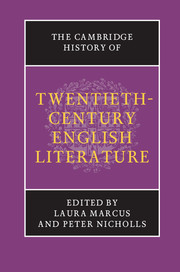Book contents
- Frontmatter
- Introduction
- PART ONE WRITING MODERNITY
- PART TWO THE EMERGING AVANT-GARDE
- PART THREE MODERNISM AND ITS AFTERMATH, 1918–1945
- 10 Trauma and war memory
- 11 The time–mind of the twenties
- 12 Modern life: fiction and satire
- 13 Modernist poetry and poetics
- 14 Modernity and myth
- 15 Psychoanalysis and literature
- 16 Biography and autobiography
- 17 ‘Speed, violence, women, America’: popular fictions
- 18 Theatre and drama between the wars
- 19 Literature and cinema
- 20 The thirties: politics, authority, perspective
- 21 Literary criticism and cultural politics
- 22 Surrealism in England
- 23 World War II: contested Europe
- 24 World War II: the city in ruins
- PART FOUR POST-WAR CULTURES, 1945–1970
- PART FIVE TOWARDS THE MILLENNIUM, 1970–2000
- Bibliography
- Index
- References
21 - Literary criticism and cultural politics
from PART THREE - MODERNISM AND ITS AFTERMATH, 1918–1945
Published online by Cambridge University Press: 28 March 2008
- Frontmatter
- Introduction
- PART ONE WRITING MODERNITY
- PART TWO THE EMERGING AVANT-GARDE
- PART THREE MODERNISM AND ITS AFTERMATH, 1918–1945
- 10 Trauma and war memory
- 11 The time–mind of the twenties
- 12 Modern life: fiction and satire
- 13 Modernist poetry and poetics
- 14 Modernity and myth
- 15 Psychoanalysis and literature
- 16 Biography and autobiography
- 17 ‘Speed, violence, women, America’: popular fictions
- 18 Theatre and drama between the wars
- 19 Literature and cinema
- 20 The thirties: politics, authority, perspective
- 21 Literary criticism and cultural politics
- 22 Surrealism in England
- 23 World War II: contested Europe
- 24 World War II: the city in ruins
- PART FOUR POST-WAR CULTURES, 1945–1970
- PART FIVE TOWARDS THE MILLENNIUM, 1970–2000
- Bibliography
- Index
- References
Summary
This chapter examines the role played in cultural politics between the wars by attempts to address changing configurations of literature and readership, mainly in the creation of new journals and magazines, and also in the emergence of a new, vociferous and non-bellettristic form of literary criticism which would have a major impact on the development of literary studies. Serial publications are an important focus, because they are invariably bids to create a literary or cultural public sphere in a changing cultural climate. The nature of the reader and the role of the artist are put into question in these journals, not only in editorials but also in the editorial decisions which shape their contents. The background to this re-evaluation of writing and readership was the continuing extension of literacy following successive Education Acts, the commercialisation of written and other forms of culture, and a perceived extension of the power and importance of the working class. Serious literary authors and critics, the majority of whom were privately educated and belonged to comparatively wealthy families, were confronted by difficult questions concerning the role of high literature and art, and the meaning and purpose of its relationship to any possible audience. Especially in the 1920s, some writers and editors advocated conservatism and a return to religious and institutional order as an alternative to mass democracy or Communism. By the 1930s, new voices had emerged supporting anti-Fascist struggle and seeking to create an alliance of the cultural upper-middle class and the proletariat.
- Type
- Chapter
- Information
- The Cambridge History of Twentieth-Century English Literature , pp. 379 - 395Publisher: Cambridge University PressPrint publication year: 2005

